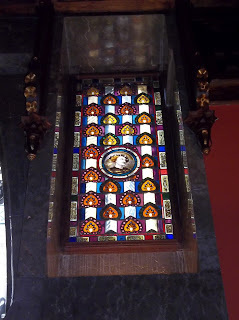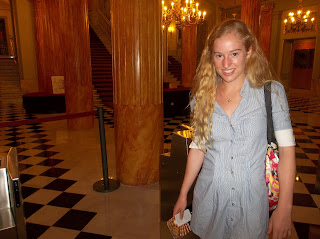Located on Las Ramblas, I pass this beautiful building several times a week. The guided tours are only at 10 am (unguided tours are available at other hours), though, so I kept scheduling my visit for weekends. Weekends that would fill up unexpectedly in other ways. But, this Sunday morning, I dragged myself out of bed and scuttled over to Teatre Liceu.
The theatre has always had a wide-ranging program and attracted big names and big productions. It puts on 12 operas a year, as well as about 60 other different performances. Just as its programs combine modern triumphs with timeless classics (Aida goes up this Saturday), the theater is likewise a mix of old and new. This is not intention, though. The theater has been rebuilt twice after fires, both of which partially demolished the structure. The first fire, in the late 19th century, is believed to have been caused by an iron that caught some fabric (a costume?) on fire. The second, which occurred during the 1990s, was caused by workers who were smelting something above the stage, according to our guide. The English was a little rough.
Upstairs, just outside a balcony overlooking the main foyer (used for intermissions as well as business dinners, chamber music concerts, pre-opera lectures series, and for late comers who can watch the remainder of the first act on screens and then find their seats during intermission) is this unique statue.
We then returned to the main entrance, which used to be only the entrance for the wealthier patrons whose seats were on the ground through third floors. The poorer opera-lovers who sat on the fourth and fifth floors had to enter through a separate side entrance.
At the top of the stairs is a statue of the Muse of Music.
The next stop was one of the perks of the guided tour, a private club called Circulo de Teatre Liceu (Liceu Theater Circle) that was opened the same year as the theater itself. While most of its members are also patrons of the arts, the club and theater are otherwise completely independent. No pictures were allowed inside the club, but let your imagination loose: it was beautiful, with rich decorations, walls hung in beautiful paintings of laughing theater-goers mingling and ladies displaying jewels and veiled smiles. Many of the paintings were by famous Catalan artist Ramon Casas (whose house I went to; it is now occupied by the interior design store Vincons). In fact, when a new room of the club was built, he was asked to decorate it. He painted twelve beautiful oil paintings related to the arts and music of the day (mostly scenes from Catalunya, but one from Paris) that seem to glow in the dim room. As you wander toward the club entrance, a trilogy of scenes in stained glass glitter to one side. Everything is beautiful. As one of my fellow tour members said of the Newspaper Room, "I would read the newspaper here every day. Heck, I would read every newspaper I could get my hands on." The club, like the theater, has adapted to more modern times. Small buttons by the couches, which used to ring for waiter service, are now mostly disconnected. Ornate grills in the walls are no longer part of the heating system, but merely for decoration. But these and other details help the club to retain an air of a long-forgotten charm, elegance, and the kind of beauty that makes you smile and sigh.
Entrance to the club requires not only lots of money, but the recommendation of two members. Oh, and it was only opened to women members (women could previously come as guests) five years ago, so only 40 of the ~1000 members are women. Most of the members are from Catalunya, but foreign members are also welcome. There is hope for me yet.
Still, the parts of the theater open to us normal people are also beautiful. The Hall of Mirrors, which was not damaged in the fires, shines with the light of chandeliers reflected hundreds of times and the gilt lettering detailing the declarations of music's power and reach, such as "Music has no nationality."
All in all, the theater was beautiful and definitely worth the struggles I had getting out of bed.
A few other fun facts about the Teatre Licue:
- It has dragon-shaped candelabras
- The ceiling in the auditorium has "medallions" depicting waving mountains of... the red velvet chairs of an auditorium
- Since everyone loved Wagner here (several theaters have Wagner shout-outs, including Teatre Liceu and Palau de la Musica Catalana), his name is gilded in one of the medallions above the stage
- The theater seats over 2000 people, the second largest theater in Europe without an artificial sound system. That is, whatever sound you produce is whatever the audience hears. Lip-syncers not welcome.
- The theater differs from other theaters of the time in that it has no royal box. After the first fire, the government in Madrid refused to help pay for reconstruction, so the theater refused to build a royal box. (Note: walls of certain boxes can be moved to accommodate important guests and their security details).
After a siesta, I returned to the lower Ramblas to visit Palau Guell.
Palau Guell was the urban residence of the Guell family that basically made Gaudi's career. Sure, he had a few projects for the city and other private commissions beforehand, but when you hear Gaudi's name, it's often on a Something Guell audioguide.
The inside of Palau Guell is beautiful, although I can't imagine living the kind of lifestyle a residence such as that suggests. After all, what normal family has an organist in residence, a hallway of stained glass for presenting the children's artistic works, a Hall of Intimates for piano recitals, or a private chapel lined with gold? But I'm getting ahead of myself.
Palau Guell is not as striking as Gaudi's later work (coughcoughCasaBattlocoughcough), but it has the beginnings of all those ideas: the faintest of undulating curves, beautiful decorative stained glass, the use of tiles for utility (easy cleaning of a room that horses - and their bugs - passed through) and beauty, nature motifs and a bit of Oriental influence. It's all there. It's just a bit more subdued at this point, as if Gaudi was not yet ready to let his imagination run free and had left it tethered.
 Everywhere you looked, there was gorgeous woodcarving and intricate detailing. This wooden bird, with it's metal beak, was just your average everyday decorative pillar adornment, if you were a Guell.
Everywhere you looked, there was gorgeous woodcarving and intricate detailing. This wooden bird, with it's metal beak, was just your average everyday decorative pillar adornment, if you were a Guell. The ceiling of the main hall; note the organ pipes high above. This hall was lushly decorated and used for practically everything: concerts, parties, greeting old friends, Sunday church services...
The ceiling of the main hall; note the organ pipes high above. This hall was lushly decorated and used for practically everything: concerts, parties, greeting old friends, Sunday church services... Within the main hall, these two enormous doors open onto a gilded chamber. The doors have portraits of the apostles, and this chamber transforms the hall into a place of worship.
Within the main hall, these two enormous doors open onto a gilded chamber. The doors have portraits of the apostles, and this chamber transforms the hall into a place of worship. More beautiful stained glass
More beautiful stained glass Since it got cold in the winter, every room is equipped with a Gaudi-designed fireplace. Most were simply curvy with contrasting stone, but this one was quite intricate. It depicts Saint Elizabeth, a reference to Guell's wife and eldest daughter.
Since it got cold in the winter, every room is equipped with a Gaudi-designed fireplace. Most were simply curvy with contrasting stone, but this one was quite intricate. It depicts Saint Elizabeth, a reference to Guell's wife and eldest daughter. In one of the rooms for the Guell's ten children, this stained glass depicted two Shakespearean characters: Hamlet and Macbeth, along with the coat of arms of their respective countries.
In one of the rooms for the Guell's ten children, this stained glass depicted two Shakespearean characters: Hamlet and Macbeth, along with the coat of arms of their respective countries. It wouldn't be a Gaudi house without the decorative chimneys adorning the roof. This tall one was in the center of the roof and covers the beautiful dome in the Main Hall.
It wouldn't be a Gaudi house without the decorative chimneys adorning the roof. This tall one was in the center of the roof and covers the beautiful dome in the Main Hall. More colorful chimneys
More colorful chimneys About half of the chimneys were covered with broken tile mosaics, though of larger pieces - and ones with their own designs instead of a solid color - than in other Gaudi constructions. The other half were made of brick. Architects have made so many beautiful designs using just brick in this city (such as the Arc de Triomf)
About half of the chimneys were covered with broken tile mosaics, though of larger pieces - and ones with their own designs instead of a solid color - than in other Gaudi constructions. The other half were made of brick. Architects have made so many beautiful designs using just brick in this city (such as the Arc de Triomf) The main staircase had a few low ceiling moments, which didn't bother me but which obviously posed a hazard for taller guests. Short people: 1, Giants: 0.
The main staircase had a few low ceiling moments, which didn't bother me but which obviously posed a hazard for taller guests. Short people: 1, Giants: 0.And now, Fun Facts About Palau Guell:
- It still has a working dumbwaiter
- Guell's fortune, in today's money, is estimated to have been at about 70 billion euros by Forbes Magazine. This, of course, explains how he could afford a palace, a worker's settlement, a park with an anticipated housing complex, and an architect who constantly changed his mind and only built with the finest quality of materials available on the globe. Oh, and Guell had several other residences and buildings, too.
- Guell's father had amassed his fortune in Cuba. His wife's father had done the same. Then Eusebi made some serious loot on the Industrial Revolution in Catalunya.
- Guell and Gaudi were BFFs. Gaudi even lived at the Palau Guell for a while.
- Guell became a count in 1911 under King Alfonso XIII.
Spotted: Sunday, July 15th is National Ice Cream Day in the United States! In 1984, Ronald Reagan designated the third Sunday in July as National Ice Cream Day (Note: July is National Ice Cream Month). So obey your former president and observe these two events "with appropriate ceremonies and activities." I will be celebrating, belatedly, tonight.
Second Spotted: My friend Ari's blog! She's a wonderful writer and has been blogging for a year! Unlike this blog, which is an excuse for me to record my European adventure, Ari is such a good writer that she can find things to fascinate her followers every week of the year. Actually, twice a week. On top of a full workload at Yale and some singing in the Glee Club, that's a tall order. Props to Ari! (Note: if you didn't notice the link earlier, see her blog here: http://fuzzymango.wordpress.com/)












No comments:
Post a Comment